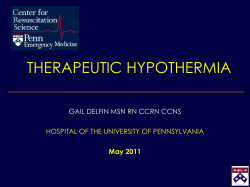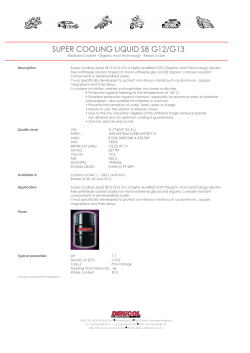
The new solution for cooling after cardiac arrest or
The new solution for cooling after cardiac arrest or heatstroke Chill with CAERvest ® 0843 CAERvest The gold standard in prehospital cooling ® CAERvest is a non-invasive, unpowered medical device which is designed to deliver instant core body cooling when needed. ® CAERvest is used by paramedics and other first responders to provide immediate core body cooling to victims of out of hospital cardiac arrest or heat stroke. By utilising proprietary technology, it acts as a life saving device and helps ensure better patient outcome. ® Various forms of cooling liquids, pre-refrigerated packs and pressurised gases have been used in attempts to apply such cooling but each requires either expensive kit or preparation. CAERvest is a portable, self-contained, single use solution that can be activated and applied earlier in the treatment protocol than has ever been possible thus offering better survival rates and outcomes. ® CAERvest has undergone human volunteer trials in the United Kingdom at the University of Brighton and has been shown to be a safe and effective device that can achieve rapid core body temperature decrease. ® CAERvest Cools when you want, where you want ® CAERvest is used to induce rapid, early therapeutic hypothermia in order to reduce tissue damage following a loss of blood perfusion after cardiac arrest, especially in the brain which is highly sensitive to hypoxia. Restoration of circulation leads to release of free radicals and other destructive processes and these are reduced by early brain cooling. ® CAERvest is also used for core body cooling after potentially lethal heatstroke, septic episodes, drug-induced or other causes of an elevated temperature. Animal studies consistently demonstrate the benefits and importance of early core body cooling in a wide range of conditions. ® CAERvest is easily and rapidly deployed in a range of adverse medical environments, is of intuitive design and requires very little training or knowledge to use. We have specifically engineered CAERvest to be a portable device such that it can be applied with no distraction from your normal CPR and ALS procedures and can be integrated seamlessly with existing protocols. It sits securely on the patient’s torso and continues cooling for over an hour even during transportation. ® ® CAERvest requires no preparation and is cooling under a minute after opening. CAERvest has a 3 year shelf life and can be kept ready for use in all emergency and response vehicles including aircraft without additional certification. As CAERvest is single use it avoids infection control issues and simplifies corporate logistics. ® ® ® Active core body cooling as provided by CAERvest is currently recommended practice by ILCOR after return of spontaneous circulation (ROSC) in VF cardiac arrest. It is essential in heat stroke, drug-induced or exercise-induced hyperpyrexia and in some cases fever, and there are indications that it may also be beneficial after ischaemic stroke, traumatic brain injury and myocardial infarction. ® Key features • • • • • • • • • • Compatible with defibrillation and Lucas™ Unique and powerfully effective No batteries, power or cabling required No refrigeration or extra equipment required Lightweight Neither toxic or invasive Rapidly activated single use Prolonged cooling power No cleaning or infection control issues Three year shelf life ILCOR recommendation: “Unconscious adult patients with spontaneous circulation after out-of-hospital cardiac arrest should be cooled to 32°C to 34°C for 12 to 24 hours when the initial rhythm was ventricular fibrillation (VF). Such cooling may also be beneficial for other rhythms or in-hospital cardiac arrest.” Therapeutic hypothermia “Sudden Cardiac Arrest (SCA) kills more people globally every year than lung cancer, breast cancer and HIV/AIDS combined.” 1 “Cardiac arrest is one of the most lethal public health problems in the United States, claiming more lives than colorectal cancer, breast cancer, prostate cancer, influenza, pneumonia, auto accidents, HIV, firearms, and house fires combined.” 2 “Cerebral metabolism (estimated by oxygen consumption, glucose utilisation, and lactate concentration) is temperature dependent. Hypothermia has been shown to reduce cerebral metabolism by decreasing all of these parameters. For each 1°C decrease in core temperature, the cerebral metabolic rate decreases by 6% to 7%.” 3 “Experimental and clinical data suggest that Therapeutic Hypothermia should be initiated as early as possible after ROSC because the extent of brain damage is related primarily to the length of ischemia.” 4 & 5 “Animal data suggest that the earlier TH is initiated and the earlier the target temperature is reached, the greater the chance of a positive outcome.” 3 “A 20% increase in the risk of death (95% confidence interval, 4% to 39%) was observed for every hour of delay to initiation of cooling.” 6 1.“First on the Scene – A Toolkit for EMS and First Responder Agencies” http://www.suddencardiacarrest.org/aws/SCAA/asset_manager/get_file/45142. 2.Centers for Disease Control and Prevention. National Vital Statistics Reports, December 29, 2011. http://www.cdc.gov/nchs/data/nvsr/nvsr60/ nvsr60_03.pdf. Accessed 9 March 2015. 3.Alzaga AG, Cerdan M, Varon J. Therapeutic hypothermia. Resuscitation 2006;70:369-80. 4.Silfvast T, Tiainen M, Poutiainen E, Roine RO. Therapeutic hypothermia after prolonged cardiac arrest due to non-coronary causes. Resuscitation 2003;57:109-12. 5.Nolan JP, Morley PT, Hoek TL, Hickey RW. Therapeutic hypothermia after cardiac arrest. An advisory statement by the Advancement Life Support Task Force of the International Liaison committee on Resuscitation. Resuscitation 2003;57:231-5. 6.Bernard SA, Smith K, Cameron P, et al. Induction of therapeutic hypothermia by paramedics after resuscitation from out-of-hospital ventricular fibrillation cardiac arrest: a randomized controlled trial. Circulation 2010;122:737-42. 7.Lundbye JB, Rai M, Ramu B, Hosseini-Khalili A, Li D, Slim HB, Bhavnani SP, Nair SU, Kluger J. Therapeutic hypothermia is associated with improved neurologic outcome and survival in cardiac arrest survivors of non-shockable rhythms. Resuscitation. 2012 Feb;83(2):202-7. 8.Tisherman SA. Targeted temperature management after cardiac arrest - how invasive do we need to be? Resuscitation. 2013 Aug;84(8):1009-10. “Less than 5% of individuals who suffer an OHCA survive to hospital discharge, and less than 40% of those admitted to ICU post-OHCA are discharged without major disability.” 7 “In simple terms, the cerebral metabolic rate for oxygen (CMRO2) is reduced by 6% for every 1°C decrease in temperature.” 7 “However, we cannot assume that faster cooling is beneficial. Until outcome benefits of new devices are demonstrated, their use may not be worth the price of device development, the price of the system, or the risk to the patient. For now, simple cooling methods work. The potential that more complex and more invasive techniques may prove to produce faster and more controlled hypothermia should not dissuade clinicians from implementing therapeutic hypothermia with simple techniques that are currently readily available.” 8 CAERvest Instructions for use ® 1 PREPARE PATIENT • Make sure patient is lying flat on back. • If needed, apply defibrillator pads to patient. • Continue resuscitation as per protocol. CAUTION Resuscitation should not be disrupted by use of CAERvest . ® 2 UNPACK & UNROLL VEST • Remove fluid bag and vest from package. • Tear protective wrapper from vest and identify connectors on vest and fluid bag. • Place vest on clean surface free from sharp debris. • Unroll vest so it lies flat, with connector facing up. 3 BEGIN COOLING • Connect fluid bag to vest by pushing connectors firmly together until they click. • Squeeze or roll fluid bag until all fluid enters vest. • When fluid bag is empty, press button on side of connector to detach bag from vest. NOTE Enhance cooling by gently tipping vest twice so fluid runs up and down channels. 4 PLACE VEST ON PATIENT’S CHEST • Place vest on patient’s chest, with connector on patient’s left side, facing up. • Slide vest towards patient’s head until vest’s wings lie under armpits. NOTE • You may place vest over defibrillation pads. • Defibrillation, external pacing and CPR may be performed with vest in place. 5 DOCUMENT USE & MONITOR PATIENT • Write current date, time and target core temperature on central panel. • Check patient’s core temperature according to protocol. NOTE If desired, reduce cooling rate by folding back part of vest to lessen contact with skin. 6 AFTER USE ® • CAERvest cools for at least one hour. • When cooling power declines, gently lift vest from patient’s chest and replace with new CAERvest if required (repeat steps 1–5). ® • DO NOT place multiple vests on patient’s chest at same time. WARNING When removing vest, carefully lift it from torso to avoid damaging sensitive skin. Issue 1.0 The new gold standard in reliable, effective, prehospital cooling Call CPR Defibrillation Chill Care BodyChillz Ltd. The Beehive, City Place, Gatwick, West Sussex RH6 0PA +44 (0)1293 804609 www.CAERvest.com @CAERvest © BodyChillz Ltd. 2015 Designed and developed in the UK CAERvest® International Patent Application No: PCT/GB2014/053109 and PCT/GB2014/053110
© Copyright 2025











